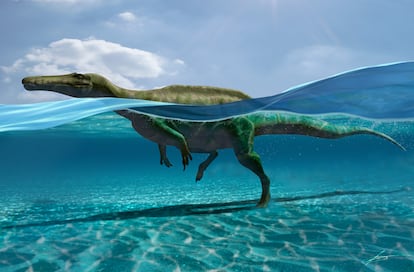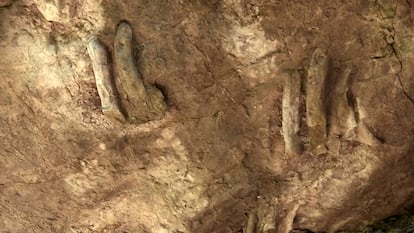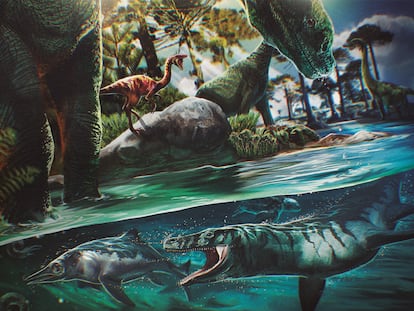Footprints of swimming dinosaurs discovered in La Rioja, Spain
The discovery consists of 27 tracks of the predators from 120 million years ago, showing that the animals were capable of crossing large volumes of water

La Rioja, Spain, is a small community (with 323,465 inhabitants, according to the National Statistics Institute, INE), but it has a vast paleontological heritage that extends over 170 sites, which have nearly 11,000 dinosaur footprints, as well as different bone sediments.
The most recent discovery located fossil remains belonging to dinosaur species that knew how to swim or were at least able to swim through large volumes of water. University of La Rioja researcher Pablo Navarro has identified 27 footprints (ichnites) of this kind of dinosaur—bipedal, non-avian (ancestor of birds) and tridactyl (three-toed)—which inhabited La Rioja over 120 million years ago during the Early Cretaceous period.
“They are ichnites with special morphologies, since they belong to dinosaurs that were swimming, not walking, which is the most common behavior in the footprints that we see in La Rioja and in other parts of the planet,” says Navarro of this discovery in Laguna de Cameros. The tracks are of variable length (from 8.5 to 29.2 centimeters, or 3.3 inches to 11.5 inches) and the dimensions change depending on the animal’s posture and movements when it touched the bottom of the water. At the site, “larger and smaller marks have been found, which could correspond to different species or to adult and young dinosaurs of the same species,” Navarro explains.
The researcher attributes the footprints to spinosaurids (bipedal predators) that were trying to get over the water flow. According to Navarro, the dinosaurs “could use different techniques to swim.” The study of the ichnites (footprints) suggests that “the animal’s body floated partially or completely.” For this reason, in the first case, the footprints are elongated, while in the second, they more clearly show the tips of the toes that the dinosaurs used to balance their gait and keep moving forward.

Navarro explains that “there was already evidence” in La Rioja of this aquatic ability of dinosaurs specifically at the Virgen del Campo site, in Enciso, a town located 24 kilometers from Laguna de Cameros but in another Ebro river valley and separated by a mountain range. According to the University of La Rioja paleontologist, there are only a dozen sites of ichnites of swimming dinosaurs in the world.
The Laguna de Cameros site was discovered in 2020 by Jorge Tierno, a resident of this small town with a population of just over 100 inhabitants. Scientists from the universities of La Rioja, Complutense (Madrid), País Vasco, Nacional de Río Negro (Argentina) and Cantabria, as well as the Geological and Mining Institute of Spain, were also involved in this research.
“We found 27 footprints and there is no other evidence. They are on a cliff, in an area that is not very accessible,” explains Navarro. In another town in La Rioja, Igea, Navarro also identified footprints of theropods that could run at 45 kilometers (28 miles) per hour, one of the highest speeds recorded for this type of dinosaur.
The most complete bone remains of the spinosaurid dinosaur in Europe were also found in this area of La Rioja. The animal had enormous dimensions; it was 8 meters (26 feet) long and 2.5 meters (8 feet) tall and weighed close to a ton and a half. The dinosaur lived in the mountains of what is now La Rioja 120 million years ago during the Early Cretaceous period.
Sign up for our weekly newsletter to get more English-language news coverage from EL PAÍS USA Edition
Tu suscripción se está usando en otro dispositivo
¿Quieres añadir otro usuario a tu suscripción?
Si continúas leyendo en este dispositivo, no se podrá leer en el otro.
FlechaTu suscripción se está usando en otro dispositivo y solo puedes acceder a EL PAÍS desde un dispositivo a la vez.
Si quieres compartir tu cuenta, cambia tu suscripción a la modalidad Premium, así podrás añadir otro usuario. Cada uno accederá con su propia cuenta de email, lo que os permitirá personalizar vuestra experiencia en EL PAÍS.
¿Tienes una suscripción de empresa? Accede aquí para contratar más cuentas.
En el caso de no saber quién está usando tu cuenta, te recomendamos cambiar tu contraseña aquí.
Si decides continuar compartiendo tu cuenta, este mensaje se mostrará en tu dispositivo y en el de la otra persona que está usando tu cuenta de forma indefinida, afectando a tu experiencia de lectura. Puedes consultar aquí los términos y condiciones de la suscripción digital.
More information
Últimas noticias
There is as much life left to discover on planet Earth as that which is already known
Dozens presumed dead, around 100 injured in fire at Swiss Alps bar during New Year’s celebration
Is porn for women different from conventional porn? We spoke to those who make it
Cartagena de Indias is sinking: What can the city do to mitigate it?
Most viewed
- Reinhard Genzel, Nobel laureate in physics: ‘One-minute videos will never give you the truth’
- David King, chemist: ‘There are scientists studying how to cool the planet; nobody should stop these experiments from happening’
- Oona Chaplin: ‘I told James Cameron that I was living in a treehouse and starting a permaculture project with a friend’
- Sinaloa Cartel war is taking its toll on Los Chapitos
- The Interoceanic Train, the Mexican alternative to the Panama Canal









































